2011年8月由 Discovery Channel 播映的節目《絕對好奇 - 第一季:上帝造宇宙?(Curiosity - Season 1:Did God Create the Universe?)》。
史蒂芬霍金提出他個人最強烈的大哉問:是誰?或是什麼事物創造了我們居住的宇宙?在本集節目中,我們將利用物理學與宇宙學,解答哲學家數千年來的疑問。
Showing posts with label Space universe. Show all posts
Showing posts with label Space universe. Show all posts
Friday, November 9, 2012
Monday, November 5, 2012
Wednesday, September 19, 2012
Sunday, February 5, 2012
Fourth potentially habitable planet is discovered

~ NASA handout image from 2009 shows a view of a colorful assortment of 100,000 stars residing in the crowded core of a giant star cluster.
International astronomers said on Thursday they have found the fourth potentially habitable planet outside our solar system with temperatures that could support water and life about 22 light-years from Earth.
The team analyzed data from the European Southern Observatory about a star known as GJ 667C, which is known as an M-class dwarf star and puts out much less heat than our Sun.
However, at least three planets are orbiting close to the star, and one of them appears to be close enough that it likely absorbs about as much incoming light and energy as Earth, has similar surface temperatures and perhaps water.
The new rocky planet, GJ 667Cc, orbits its star every 28.15 days -- meaning its year equals about one Earth month -- and has a mass at least 4.5 times that of Earth, according to the research published in Astrophysical Journal Letters.
"This planet is the new best candidate to support liquid water and, perhaps, life as we know it," said Guillem Anglada-Escudé who was with the Carnegie Institution for Science when he conducted the research but has since moved on to the University of Gottingen in Germany.
The theory about water, however, cannot be confirmed until astronomers learn more about the planet’s atmosphere.
Other planets circling the same star -- which is part of a three-star system -- could include a gas-giant and an additional super-Earth with an orbital period of 75 days, but more observations are needed to confirm that.
Some experts have been skeptical that M-class dwarf stars could have planets that support life because they are too dim and tend to have lots of solar flare activity which could send off lethal radiation to nearby planets.
And even though this star, GJ 667C, has a much lower abundance of elements heavier than helium, such as iron, carbon, and silicon -- the building blocks of terrestrial planets -- than our Sun, astronomers are intrigued by the possibilities.
"This was expected to be a rather unlikely star to host planets. Yet there they are, around a very nearby, metal-poor example of the most common type of star in our galaxy," said co-author Steven Vogt, a professor of astronomy and astrophysics at University of California Santa Cruz.
"The detection of this planet, this nearby and this soon, implies that our galaxy must be teeming with billions of potentially habitable rocky planets."
French astronomers in May last year confirmed the first exoplanet, Gliese 581d, to meet key requirements for sustaining life. It is a rocky planet about 20 light-years away.
Swiss astronomers reported in August that another planet, HD 85512 b, about 36 light-years away seemed to be in the habitable zone of its star.
The US space agency NASA confirmed its first such planet late last year, Kepler 22b, about 600 light-years away.
Source : AFP News – Fri, Feb 3, 2012
Wednesday, December 21, 2011
First Earth-sized planets found beyond solar system

~ An artist's rendering shows a planet called Kepler-20e in this handout released December 20, 2011.
Article By Irene Klotz
CAPE CANAVERAL, Florida (Reuters) - Astronomers have found a pair of Earth-sized planets orbiting a star similar to the sun, though neither are believed to be suitable for life, scientists on NASA's Kepler telescope team said on Tuesday.
The discovery follows confirmation earlier this month of a super-Earth sized planet, called Kepler-22b, that circles the right distance from its parent star for liquid water to exist on its surface. Water is believed to be a key ingredient for life.
"Kepler-22b has the right temperature, but it is too big. (The planets) we're announcing today are just the right size, but too hot," astronomer David Charbonneau with Harvard University, told reporters during a conference call.
"But you can bet that the hunt is on to find a planet that combines the best of both worlds, a true Earth twin," he said.
The newly discovered planets, called Kepler-20e and 20f, have at least three gas-giant siblings, one of the larger planetary systems found to date.
But the family is nothing like our solar system, where rocky worlds like Venus, Earth and Mars are grouped together closer in toward the sun while gas giants like Jupiter and Saturn are segregated in the outer regions.
The two Earth-like and three Neptune-sized planets in the Kepler-20 family are interspersed and all orbit closer to the parent star than our solar system's innermost planet, Mercury.
"Rocky planets and gas giants happily mingle together. This is the first time we've seen anything like this," Charbonneau said.
Kepler-20e and 20f, which are believed to be too hot for liquid water, probably are not habitable - at least not today.
"If Kepler-20f was formed with water, which I think is likely, then it could have held on to its water for several billions of years ," said astronomer Linda Elkins-Tanton with the Carnegie Institute in Washington D.C.
"And that means that this planet could have been habitable in the past for a long period," she said.
The system is located about 1,000 light-years away in the constellation Lyra.
Light travels at about 299,337 km per second.
(Editing by Kevin Gray and Sandra Maler)
Wednesday, September 21, 2011
Amazing Timelapse of Earth
Science educator James Drake built this amazing timelapse video from the perspective of the International Space Station as it flew over North and South America.
He created this video by downloading a series of 600 photographs that were available online at the Gateway to Astronomy Photograph of Earth, and then stitching them together into a complete video.
Sunday, September 18, 2011
US astronomers find planet with two Suns
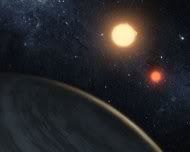
US astronomers said Thursday they have discovered the first planet that is orbiting two Suns, much like the fictional home of Luke Skywalker featured in Star Wars.
Skywalker's native planet of Tatooine was hot and desert-like, but this planet, called Kepler-16b, is a freezing cold world about the size of Saturn, orbiting two parent Suns in a near perfect circle about 200 light years away.
The planet was glimpsed with the US space agency's Kepler space telescope, which monitors the brightness of 155,000 stars, according to the research published in the journal Science.
"This discovery is stunning," said co-author Alan Boss of the Carnegie Institution for Science Department of Terrestrial Magnetism.
"Once again, what used to be science fiction has turned into reality."
While astronomers have previously glimpsed planets they believed were orbiting two stars, they had never before seen one actually passing in front of its two Suns so this discovery offers the first proof.
"Kepler-16b is the first confirmed, unambiguous example of a circumbinary planet -- a planet orbiting not one, but two stars," said co-author Josh Carter of the Harvard-Smithsonian Center for Astrophysics.
"Once again, we're finding that our solar system is only one example of the variety of planetary systems nature can create."
If there were people on Kepler-16b, they could relax to the view of a double sunset, but such a scenario is highly unlikely due to the planet's extreme frigid surface temperature of -100 to -150 Fahrenheit (-73 to -101 Celsius).
The chill is likely due to the fact that even though the planet has two Suns which it orbits every 229 days at a distance of 65 million miles (105 million kilometers), they are smaller and cooler than our single Sun.
One of Kepler-16b's Suns is 20 percent as massive as ours, and the other is 69 percent as massive.
While the planet orbits them, the two Suns dance with each other in an "eccentric 41-day orbit," the study said.
The study was led by Kepler scientist Laurance Doyle of the California-based SETI (Search for Extraterrestrial Intelligence) Institute.
AFP News – Fri, Sep 16, 2011
Sunday, September 11, 2011
NASA’s Cassini orbiter snaps unbelievable picture of Saturn
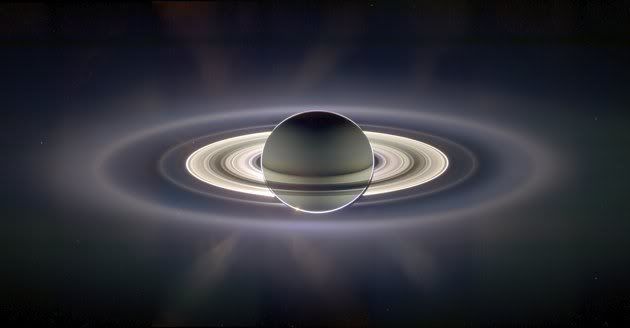
Science fiction movies have spoiled us on high definition views of our planetary neighbors, but real-life photographs with equal jaw-dropping potential are exceedingly rare. That's what makes NASA's awe-inspiring snapshot of Saturn (hi-res version here) such a stunning piece of eye candy.
Taken by NASA's Cassini robotic orbiter, the shot was captured from the dark side of Saturn as the Sun's bright rays illuminated every piece of dust and debris circling the planet. Cassini has offered astronomers a never-before-seen look at Saturn and revealed more information about the planet than any craft before it. The craft has taken so many pictures of the ringed wonder that they were recently made into a short flyby film that looks like it was created by George Lucas rather than a robotic space explorer.
The Cassini probe was launched in 1997 and took a further 7 years to reach Saturn's orbit. The total cost of its overarching objective of studying the ringed planet stands at a staggering $3.26 billion. However, the wealth of information it has wrought — including amazing pictures like the one above, and recordings of massive lightning storms on the planet — have already made it one of the best investments in space exploration. Hopefully Juno — which began a 5-year trek to Jupiter just last month — will bring us some equally stunning shots of Saturn's neighbor.
Article By :Mike Wehner, Thu, Sep 8, 2011
Monday, August 22, 2011
The Strangest Alien Planets
By SPACE.com Staff @ 17 May 2011
The Smallest
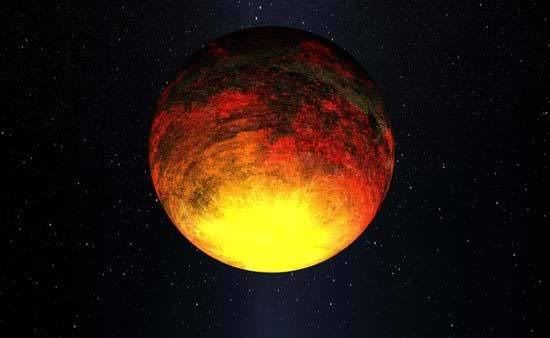
Credit: NASA
This artist's concept of Kepler-10b shows the smallest known exoplanet, announced in January 2011.
The Former Champ
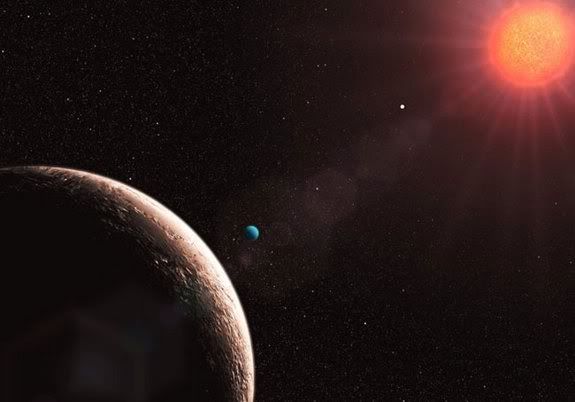
Credit: ESO/L. Calcada
Gliese 581 e used to hold the title of smallest alien planet. However, it was dethroned in January 2011, with the announcement of Kepler-10b.
The Biggest
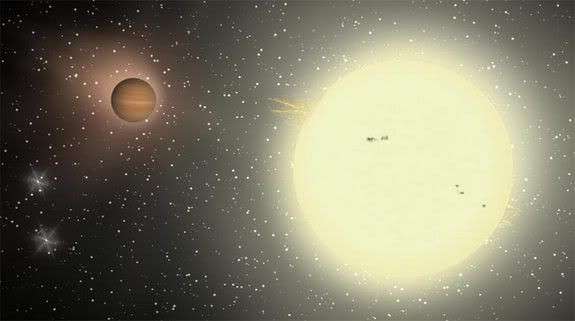
Credit: Jeffrey Hall, Lowell Observatory
The largest exoplanet ever discovered is also one of the strangest and theoretically should not even exist, scientists say. Dubbed TrES-4, the planet is about 1.7 times the size of Jupiter and belongs to a small subclass of so-called puffy planets that have extremely low densities. The planet is located about 1,400 light years away from Earth and zips around its parent star in only three and a half days
Closest Alien World to Us
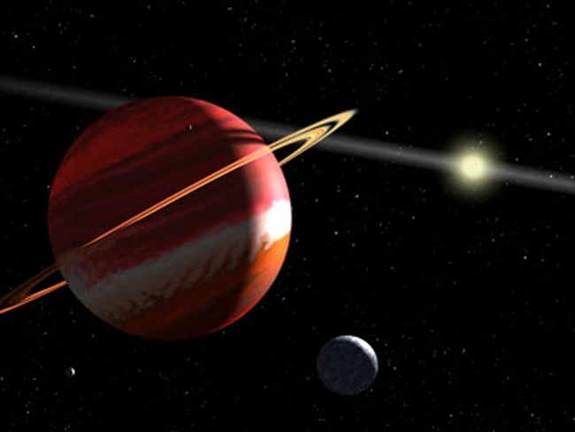
Credit: NASA, ESA, G.F. Benedict (University of Texas, Austin)
Epsilon Eridani b orbits an orange Sun-like star only 10.5 light years away from Earth. It is so close to us telescopes might soon be able to photograph it. It orbits too far away from its star to support liquid water or life as we know it, but scientists predict there are other stars in the system that might be good candidates for alien life.
Volcanic Nightmare
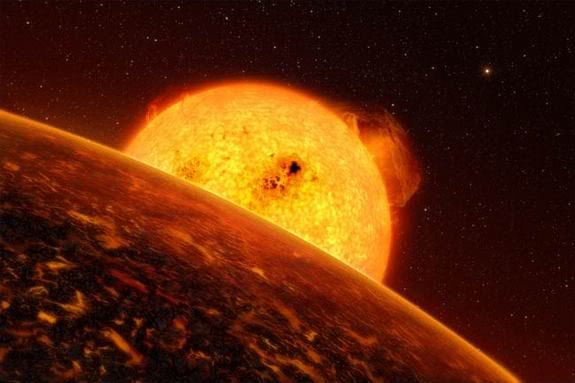
Credit: ESO/L. Calcada
This planet, CoRoT-7b, was the first confirmed rocky world outside our solar system, but it doesn't look like a particularly pleasant place to live. It is tidally locked to its parent star, sees hellish 4,000 degrees Fahrenheit (2,200 degrees Celsius). It may also rain rocks and be the core of a vaporized gas giant.
Multiple Sunsets Like Tatooine
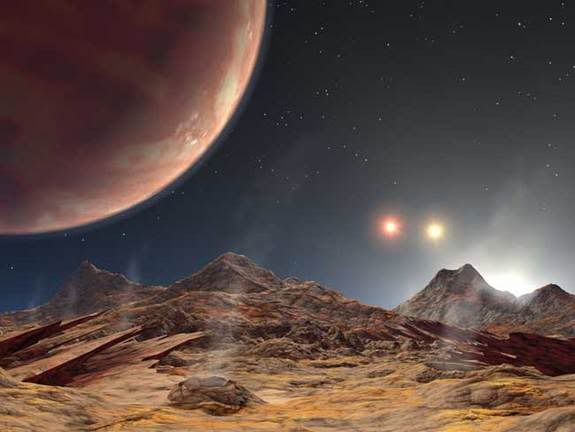
Credit: NASA/JPL's Planetquest/Caltech
Luke Skywalker’s home planet of Tatooine in Star Wars had two suns, but that’s paltry compared to a Jupiter-like planet 149 light-years from Earth. This planet has three suns, with the main star similar in mass to our own sun. The triple-star system is known as HD 188753. Like Tatooine, the planet there is likely pretty hot – it orbits very close to the main star, completing one orbit every 3.5 days.
Coldest and Farthest From Us
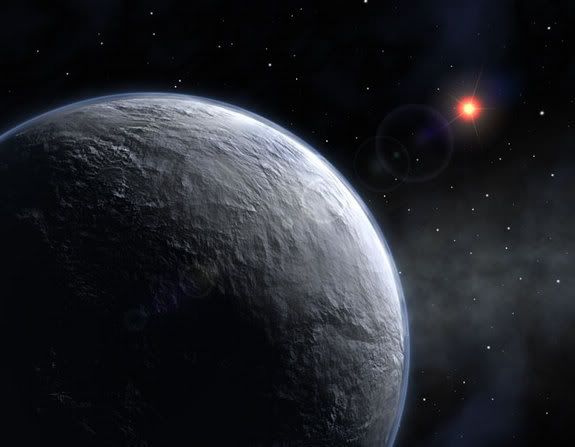
Credit: ESO
With a surface temperature of -364 degrees Fahrenheit (-220 degrees Celsius), the extrasolar planet known as OGLE-2005-BLG-390L b is likely the coldest alien world. It is about 5.5 times as massive as Earth and thought to be rocky. It orbits a red dwarf star about 28,000 light-years away, making it the most distant exoplanet currently known.
Hottest World
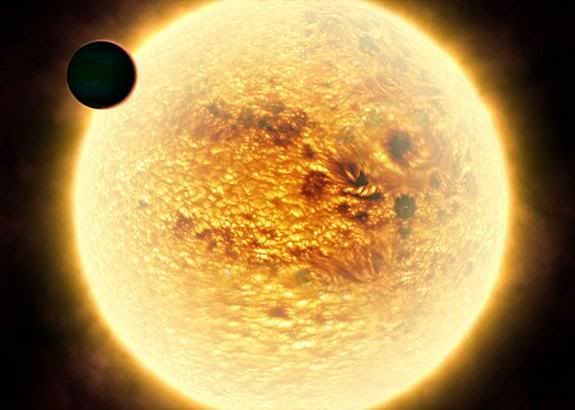
Credit: ESA/NASA/Frederic Pont, Geneva University Observatory
A planet called WASP-12b is the hottest planet ever discovered (about 4,000 degrees Fahrenheit, or 2,200 degrees Celsius), and orbits its star closer than any other known world. It orbits its star one every Earth day at a distance of about 2 million miles (3.4 million km). WASP-12b is a gaseous planet, about 1.5 times the mass of Jupiter, and almost twice the size. It is 870 light-years from Earth
Super-Earth
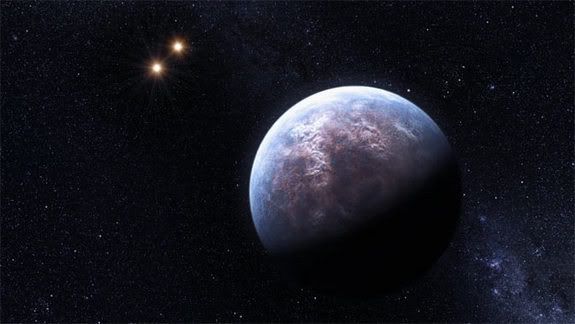
Credit: ESO
Astronomers are finding many worlds now in a category of worlds called Super-Earths, which are between 2 and 10 times the mass of our own Earth. Some scientists think such worlds could be more susceptible to forming the conditions for life because their cores are hot and would be conducive to geological upheaval through volcanism and plate tectonics
Oldest Alien Planet
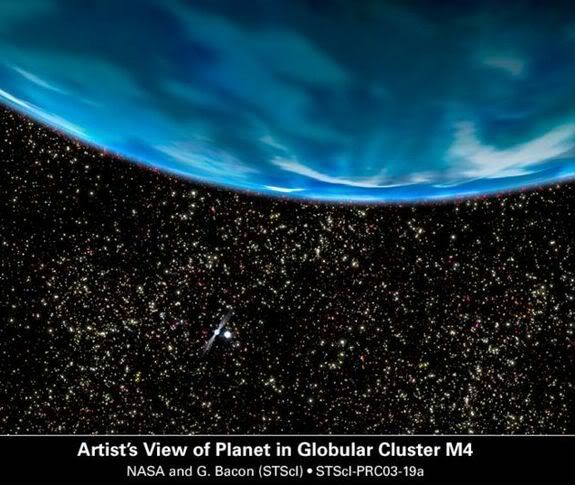
Credit: NASA and H. Richer (U. British Columbia)
The oldest known planet is a primeval world 12.7 billion years old that formed more than 8 billion years before Earth and only 2 billion years after the Big Bang. The discovery suggested planets are very common in the universe and raised the prospect that life began far sooner than most scientists ever imagined.
The Youngest Known Exoplanet
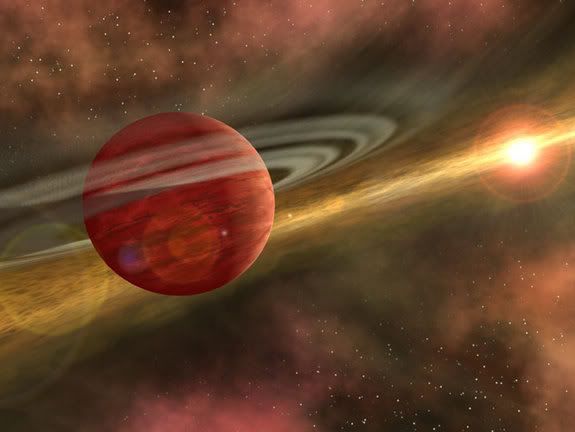
Credit: NASA
The youngest exoplanet yet discovered is less than 1 million years old and orbits Coku Tau 4, a star 420 light-years away. Astronomers inferred the planet’s presence from an enormous hole in the dusty disk that girdles the star. The hole is 10 times the size of Earth’s orbit around the Sun and probably caused by the planet clearing a space in the dust as it orbits the star.
The Puffiest
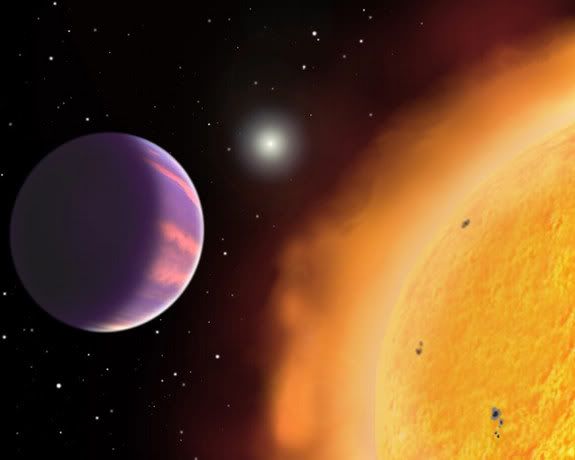
Credit: David A. Aguilar/Harvard-Smithsonian Center for Astrophysics
A planet lighter than a ball of cork is one of the puffiest alien planets known to date. Called HAT-P-1, the planet is about half as massive as Jupiter but about 1.76 times wider-or 24 percent larger than predicted by theory. It could float in water, if there was a tub large enough to hold it.
Super Neptune
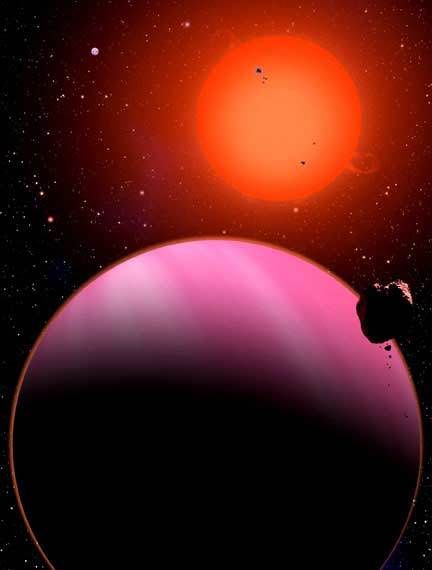
Credit: David A. Aguilar, CFA
While Neptune has a diameter 3.8 times that of Earth and a mass 17 times Earth's, the new world (named HAT-P-11b) is 4.7 times the size of Earth and has 25 Earth masses. The newfound world orbits very close to its star, revolving once every 4.88 days. As a result, it is baked to a temperature of around 1100 degrees F.
The star itself is about three-fourths the size of our Sun and somewhat cooler.
Tilted World
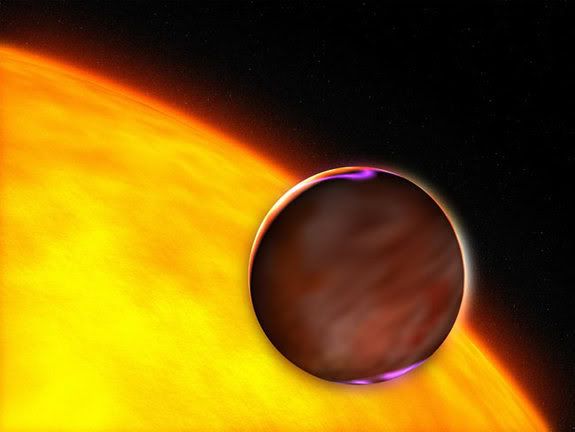
Credit: NASA. ESA, amd G. Bacon (STScI)
Most planets orbit in a plane that corresponds to their parent star's equator. But XO-3b orbits with a crazy tilt of 37 degrees from its star's equator. The only other known example of such an oddly angled orbit was Pluto, until its demotion
to dwarf planet status. There is, however, a planet known to orbit backwards around its parent star.
Fastest Planet
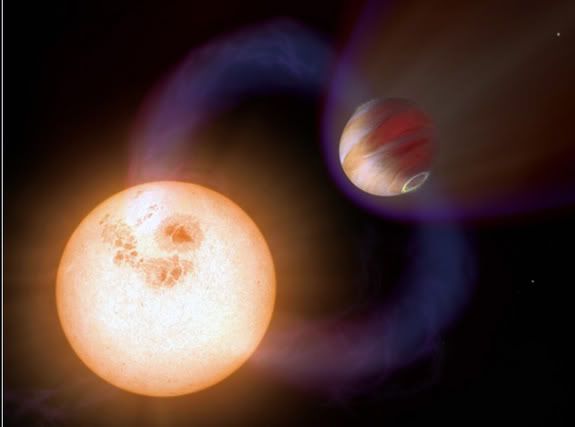
Credit: NASA, ESA, A. Schaller (for STScI)
SWEEPS-10 orbits its parent star from a distance of only 740,000 miles, so close that one year on the planet happens every 10 hours. The exoplanet belongs to a new class of zippy exoplanets called ultra-short-period planets (USPPs), which have orbits of less than a day.
Waterworld
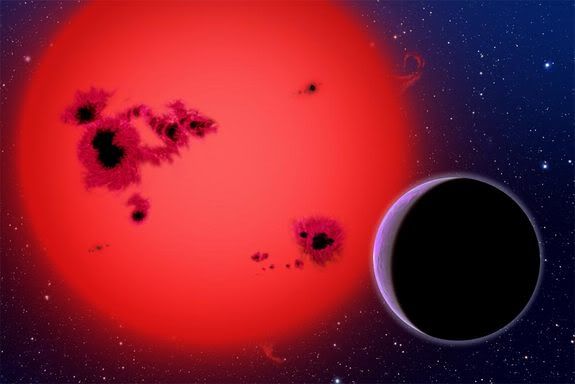
Credit: David A. Aguilar, CFA
The extrasolar planet GJ 1214b is a rocky planet rich in water that sits about 40 light-years away. It orbits a red dwarf star. It is the only known "Super-Earth" exoplanet — worlds that have masses between Earth and Neptune — with a confirmed atmosphere. The planet is about three times the size of Earth and about 6.5 times as massive. Researchers think it is likely a water world with a solid center.
Atmosphere Detected
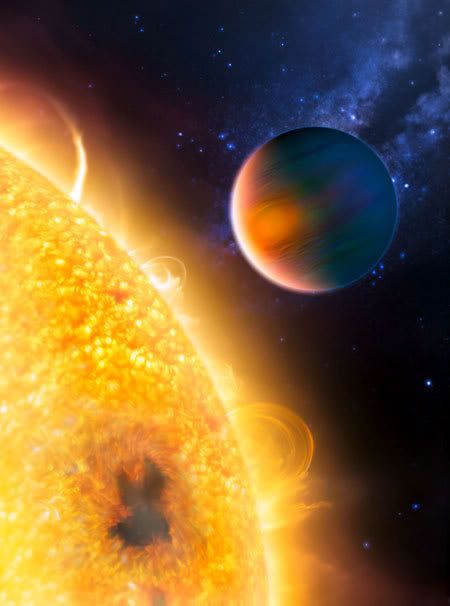
Credit: ESA, NASA and G. Tinetti
Astronomers have been able to detect the atmospheres around several exoplanets, including HD 189733b – one of the first alien words to have its atmosphere sniffed to determine its composition. Glowing methane, which can be produced naturally or be a biological byproduct, has been detected on the planet.
Endangered World
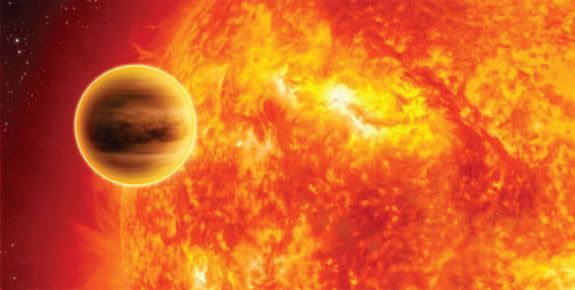
Credit: CARREAU/ESA/Nature
When astronomers observed WASP-18b, they may have seen it in the cosmic moment before its death. This planet, possibly an ill-fated world, whips around its star in less than one Earth day. Scientists think that this speed coupled with the planet's heft yields strong gravitational tugs that can alter the planets orbit. If the planet orbits faster than its star spins, it should gradually be moving inward towards its sun, and its doom.
Most Habitable
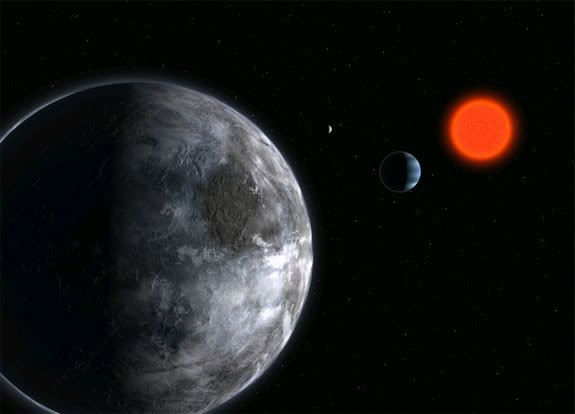
Credit: ESO
One of the several planets within the Gliese 581 star system, called Gliese 581 d, may be one of the most potentially habitable alien worlds known. It is about 8 times the mass of Earth, and located in an orbit just right for liquid water to exist on the surface. Water is a key ingredient for life as we know it. Gliese 581 is a red dwarf star 20.5 light-years from Earth
Densest Planet
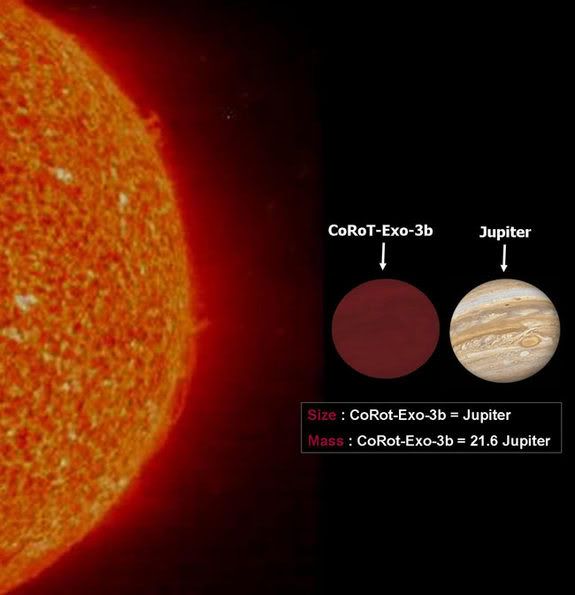
Credit: ESO/OAMP
One of the densest exoplanet to date is a world known as COROT-exo-3b. It is about the size of Jupiter, but 20 times that planet’s mass, making it about twice as dense as lead. Scientists have not ruled out that the COROT-exo-3b may be a brown dwarf, or failed star.
The Smallest

Credit: NASA
This artist's concept of Kepler-10b shows the smallest known exoplanet, announced in January 2011.
The Former Champ

Credit: ESO/L. Calcada
Gliese 581 e used to hold the title of smallest alien planet. However, it was dethroned in January 2011, with the announcement of Kepler-10b.
The Biggest

Credit: Jeffrey Hall, Lowell Observatory
The largest exoplanet ever discovered is also one of the strangest and theoretically should not even exist, scientists say. Dubbed TrES-4, the planet is about 1.7 times the size of Jupiter and belongs to a small subclass of so-called puffy planets that have extremely low densities. The planet is located about 1,400 light years away from Earth and zips around its parent star in only three and a half days
Closest Alien World to Us

Credit: NASA, ESA, G.F. Benedict (University of Texas, Austin)
Epsilon Eridani b orbits an orange Sun-like star only 10.5 light years away from Earth. It is so close to us telescopes might soon be able to photograph it. It orbits too far away from its star to support liquid water or life as we know it, but scientists predict there are other stars in the system that might be good candidates for alien life.
Volcanic Nightmare

Credit: ESO/L. Calcada
This planet, CoRoT-7b, was the first confirmed rocky world outside our solar system, but it doesn't look like a particularly pleasant place to live. It is tidally locked to its parent star, sees hellish 4,000 degrees Fahrenheit (2,200 degrees Celsius). It may also rain rocks and be the core of a vaporized gas giant.
Multiple Sunsets Like Tatooine

Credit: NASA/JPL's Planetquest/Caltech
Luke Skywalker’s home planet of Tatooine in Star Wars had two suns, but that’s paltry compared to a Jupiter-like planet 149 light-years from Earth. This planet has three suns, with the main star similar in mass to our own sun. The triple-star system is known as HD 188753. Like Tatooine, the planet there is likely pretty hot – it orbits very close to the main star, completing one orbit every 3.5 days.
Coldest and Farthest From Us

Credit: ESO
With a surface temperature of -364 degrees Fahrenheit (-220 degrees Celsius), the extrasolar planet known as OGLE-2005-BLG-390L b is likely the coldest alien world. It is about 5.5 times as massive as Earth and thought to be rocky. It orbits a red dwarf star about 28,000 light-years away, making it the most distant exoplanet currently known.
Hottest World

Credit: ESA/NASA/Frederic Pont, Geneva University Observatory
A planet called WASP-12b is the hottest planet ever discovered (about 4,000 degrees Fahrenheit, or 2,200 degrees Celsius), and orbits its star closer than any other known world. It orbits its star one every Earth day at a distance of about 2 million miles (3.4 million km). WASP-12b is a gaseous planet, about 1.5 times the mass of Jupiter, and almost twice the size. It is 870 light-years from Earth
Super-Earth

Credit: ESO
Astronomers are finding many worlds now in a category of worlds called Super-Earths, which are between 2 and 10 times the mass of our own Earth. Some scientists think such worlds could be more susceptible to forming the conditions for life because their cores are hot and would be conducive to geological upheaval through volcanism and plate tectonics
Oldest Alien Planet

Credit: NASA and H. Richer (U. British Columbia)
The oldest known planet is a primeval world 12.7 billion years old that formed more than 8 billion years before Earth and only 2 billion years after the Big Bang. The discovery suggested planets are very common in the universe and raised the prospect that life began far sooner than most scientists ever imagined.
The Youngest Known Exoplanet

Credit: NASA
The youngest exoplanet yet discovered is less than 1 million years old and orbits Coku Tau 4, a star 420 light-years away. Astronomers inferred the planet’s presence from an enormous hole in the dusty disk that girdles the star. The hole is 10 times the size of Earth’s orbit around the Sun and probably caused by the planet clearing a space in the dust as it orbits the star.
The Puffiest

Credit: David A. Aguilar/Harvard-Smithsonian Center for Astrophysics
A planet lighter than a ball of cork is one of the puffiest alien planets known to date. Called HAT-P-1, the planet is about half as massive as Jupiter but about 1.76 times wider-or 24 percent larger than predicted by theory. It could float in water, if there was a tub large enough to hold it.
Super Neptune

Credit: David A. Aguilar, CFA
While Neptune has a diameter 3.8 times that of Earth and a mass 17 times Earth's, the new world (named HAT-P-11b) is 4.7 times the size of Earth and has 25 Earth masses. The newfound world orbits very close to its star, revolving once every 4.88 days. As a result, it is baked to a temperature of around 1100 degrees F.
The star itself is about three-fourths the size of our Sun and somewhat cooler.
Tilted World

Credit: NASA. ESA, amd G. Bacon (STScI)
Most planets orbit in a plane that corresponds to their parent star's equator. But XO-3b orbits with a crazy tilt of 37 degrees from its star's equator. The only other known example of such an oddly angled orbit was Pluto, until its demotion
to dwarf planet status. There is, however, a planet known to orbit backwards around its parent star.
Fastest Planet

Credit: NASA, ESA, A. Schaller (for STScI)
SWEEPS-10 orbits its parent star from a distance of only 740,000 miles, so close that one year on the planet happens every 10 hours. The exoplanet belongs to a new class of zippy exoplanets called ultra-short-period planets (USPPs), which have orbits of less than a day.
Waterworld

Credit: David A. Aguilar, CFA
The extrasolar planet GJ 1214b is a rocky planet rich in water that sits about 40 light-years away. It orbits a red dwarf star. It is the only known "Super-Earth" exoplanet — worlds that have masses between Earth and Neptune — with a confirmed atmosphere. The planet is about three times the size of Earth and about 6.5 times as massive. Researchers think it is likely a water world with a solid center.
Atmosphere Detected

Credit: ESA, NASA and G. Tinetti
Astronomers have been able to detect the atmospheres around several exoplanets, including HD 189733b – one of the first alien words to have its atmosphere sniffed to determine its composition. Glowing methane, which can be produced naturally or be a biological byproduct, has been detected on the planet.
Endangered World

Credit: CARREAU/ESA/Nature
When astronomers observed WASP-18b, they may have seen it in the cosmic moment before its death. This planet, possibly an ill-fated world, whips around its star in less than one Earth day. Scientists think that this speed coupled with the planet's heft yields strong gravitational tugs that can alter the planets orbit. If the planet orbits faster than its star spins, it should gradually be moving inward towards its sun, and its doom.
Most Habitable

Credit: ESO
One of the several planets within the Gliese 581 star system, called Gliese 581 d, may be one of the most potentially habitable alien worlds known. It is about 8 times the mass of Earth, and located in an orbit just right for liquid water to exist on the surface. Water is a key ingredient for life as we know it. Gliese 581 is a red dwarf star 20.5 light-years from Earth
Densest Planet

Credit: ESO/OAMP
One of the densest exoplanet to date is a world known as COROT-exo-3b. It is about the size of Jupiter, but 20 times that planet’s mass, making it about twice as dense as lead. Scientists have not ruled out that the COROT-exo-3b may be a brown dwarf, or failed star.
10 Wildest Tries to Contact Aliens
By InnovationNewsDaily Staff
@ 05 May 2011
Since we have developed the technology, we’ve been sending messages into space ― from scientists, rock stars, students, politicians ― in the hopes that someone or something will hear them and respond. That practice of broadcasting is known as Messaging Extraterrestrial Intelligence (METI). Here are some of the messages that we have beamed into the cosmos in an attempt to get E.T.'s attention.
The Arecibo message

Credit: Cornell University
Beamed out 37 years ago, the Arecibo message is still the most powerful broadcast ever deliberately beamed into space. It was sent from Cornell University’s Arecibo radio telescope in Puerto Rico.
The transmission was aimed at the globular star cluster M13. The cluster is roughly 21,000 light-years from us, near the edge of the Milky Way galaxy, and contains approximately a third of a million stars.
Researchers worked together to create a message that contained basic information about Earth and the life it contained. It including a graphic of the Arecibo telescope, our solar system, human DNA, a stick figure of a human, and some of the biochemicals of earthly life.
The message took only three minutes to transmit, and so far, we haven’t heard back.
Pioneer 10 and 11
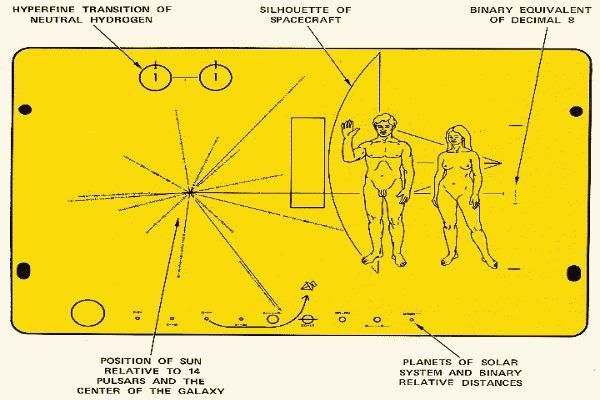
Credit: NASA
Pioneer 10 was the first spacecraft to reach Jupiter, Saturn, and beyond the solar system toward other stars. Soon afterward, Pioneer 11 followed its exact flight pattern, and presumably they’re still going, though we have lost contact.
Knowing that these two crafts would make it so far into space and would be traveling for years to come, NASA attached plaques to both Pioneer 10 and 11 with information about Earth.
The 6- by 9-inch gold anodized plaques were bolted to the spacecrafts’ frames; they depict a man – whose right hand is raised as a sign of good will – and woman. In addition, they show the layout of our solar system, as well as our sun’s position relative to a number of pulsars are shown, so that our location can be triangulated from fixed points in space. The hope is that the beings who find it can figure out whence the probe came.
Pioneer 10 was the first spacecraft to reach Jupiter, Saturn, and beyond the solar system toward other stars. Soon afterward, Pioneer 11 followed its exact flight pattern, and presumably they’re still going, though we have lost contact.
Knowing that these two crafts would make it so far into space and would be traveling for years to come, NASA attached plaques to both Pioneer 10 and 11 with information about Earth.
The 6- by 9-inch gold anodized plaques were bolted to the spacecrafts’ frames; they depict a man – whose right hand is raised as a sign of good will – and woman. In addition, they show the layout of our solar system, as well as our sun’s position relative to a number of pulsars are shown, so that our location can be triangulated from fixed points in space. The hope is that the beings who find it can figure out whence the probe came.
Voyagers’ golden record

Credit: NASA
Four years after Pioneer 11 was launched, Voyager 1 and Voyager 2 were sent out to explore Jupiter and Saturn, and NASA decided to take their message to the next level.
Voyager 1 and 2 contain a “time capsule” that, according to NASA, was “intended to communicate a story of our world to extraterrestrials.” The Voyager message is carried on a 12-inch gold-plated copper phonograph disk containing sounds and images selected to portray the diversity of life and culture on Earth.
After the section that contains the sounds of Earth, the record’s creators included a 90-minute section of music that includes both Eastern and Western classics as well as a selection of ethnic music from all over the planet.
The Voyager spacecrafts left our solar system in 1990, and it will be 40,000 years before they make it close to any other planetary system, so we still have a while to wait before we get a return message.
“A Message from Earth”
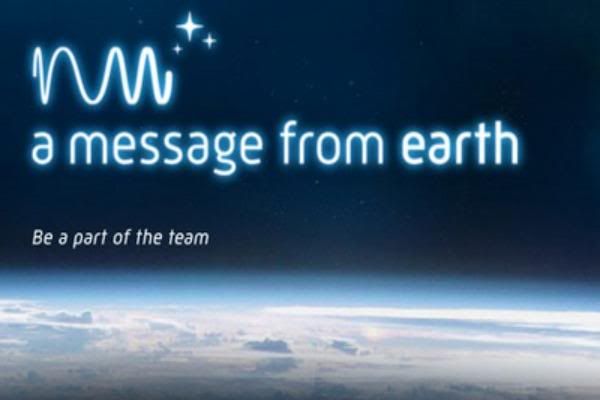
Credit: Bebo
While Facebook seems to be the social network that has achieved everything, the honor of being the first one to try to network with extraterrestrial intelligence goes to Bebo, which sent out “A Message from Earth” in 2008.
Some 501 photos, drawings and text messages from the site’s 12 million users were transmitted by the National Space Agency of Ukraine's RT-70 radar telescope, which is normally used to track asteroids. The messages were sent to the planet Gliese 581C, which is 20 light-years from Earth, in the hope they would reach intelligent alien life.
Bebo users submitted their messages as part of a competition, and 501 were translated into a binary format, so they could be sent the 120 trillion miles to the Gliese 581C. According to the competition, the messages could cover any range of topics. They should be reaching their destination in 2028.
Cosmic Calls 1 and 2
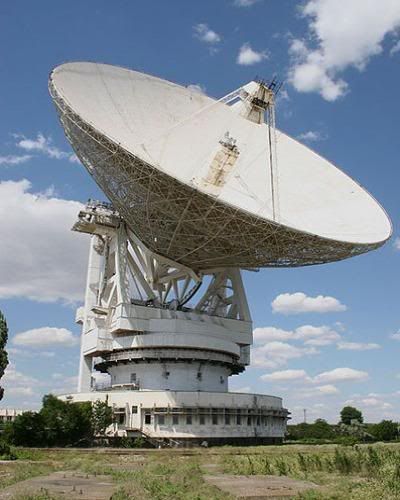
Credit: S. Korotky
Cosmic Call 1 and Cosmic Call 2, pictograms broadcast from Moscow toward various star systems, featured the “Interstellar Rosetta Stone.”
The “rosetta stone,”developed by Yvan Dutil and Stephane Dumans, was based on mathematical and scientific concepts believed to be universal. The hope was that any alien life form that intercepted the calls would be able to use it to decipher the messages.
The calls were sent out by Alexander Zaitsev, of the Russian Academy of Science in Moscow to sunlike stars within 70 light-years. The first Cosmic Call was beamed toward four separate star systems, 16 Cyg A, Gliese 777, HD 178428 and 15 Sge. The second, reached out to five stars, including 55 Cancri, which is home to a complex planetary system.
The second message also included 50 personal messages from individuals including David Bowie and elementary students from the Ukraine.
The Teen-Age Message
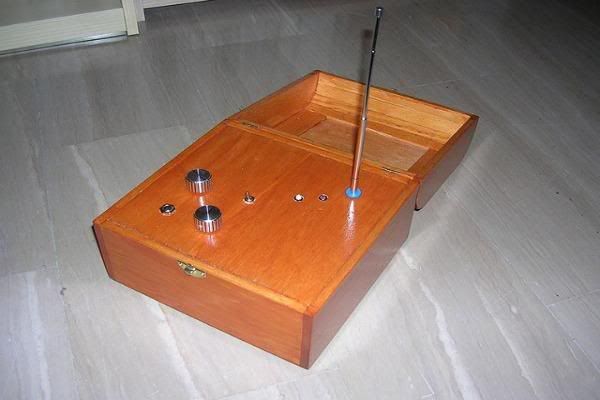
Credit: Farnea via Flickr
In addition to the Cosmic Calls, Zaitsev had his hand in the Teen-Age Message, which was a transmission put together by students from all across Russia.
The TAM transmission was sent out in six sessions in August and September 2001 from the Evpatoria Deep Space Center. It was transmitted to six nearby sunlike stars, some of them with at least one planet.
Like the Arecibo message, TAM had digital information, but Zaitsev and the students decide to include that information in analog format as well, to “compensate for the uncertainty of which is more easily understood by extraterrestrials.”
TAM included personal greetings, messages about Earth, and music that was made with a theremin – the electronic instrument used to make the eerie sounds from 1950s science fiction B-movies.
Doritos commercial

Credit: Doritos
In a 2008 publicity campaign, radars in the Arctic Circle broadcast six hours of a repeating Doritos commercial. Surprisingly, it has not made us targets of an alien attack.
The ad was directed toward a solar system in the Ursa Major constellation, which is only 42 light-years away from Earth. This system has a “habitable zone,” which scientists believe could be host to an Earth-like planet and extraterrestrial life.
The EISCAT European space station on the Norwegian island of Svalbard sent the message using its array of radars. It was sent as an MPEG file coded into 1s and 0s. Researchers agreed that the message would look just like a random series, but they hoped that through its repetition, extraterrestrials would identify the message as intelligent.
RuBisCo message

Credit: U.S. Department of Energy
On the thirty-fifth anniversary of the original Arecibo message, MIT biology fellow and artist Joe Davis sent the genetic code for the plant enzyme RuBisCo into space.
RuBisCo, which is essential for photosynthesis, is the most abundant protein on Earth, which is why Davis selected it to represent life on Earth.
According to Peter Weigele of New England Biolabs, “The choice of this molecule for broadcast communicates the central importance of our sun in sustaining life as well as an implicit understanding of the role of [carbon dioxide] in our biogeochemical systems. This is a message that is both timely and timeless – for the universe and here on Earth!”
This was also the first transmission that required the aid of an iPhone. When Davis arrived at Arecibo, the encoder normally used to modulate the beam was out of commission, so he used his iPhone as an improvised source to get the new coded message modulated into the 1,000-foot-wide dish’s 2-million-watt radio beam.
“Hello from Australia”

Credit: HelloFromEearth/Cosmos Magazine
In 2009, Australia’s Cosmos magazine took a cue from Bebo and reached out to its readers to create a goodwill message to transmit through space.
The magazine’s website collected text-message-length sentiments from people all over the world. The first came from Kim Carr, Australia’s minister for innovation, industry, science and research. It said: “Hello from Australia on the planet we call Earth. These messages express our people’s dreams for the future. We want to share those dreams with you.”
It was sent from the Canberra Deep Space Communication Complex to the planet Gliese 581d ― a planet in the same system as Gliese 581c, which was the recipient of “A Message from Earth.” Australia’s message should be arriving just a year later, in 2010.(original text puts 2029?)
Kepler DVD
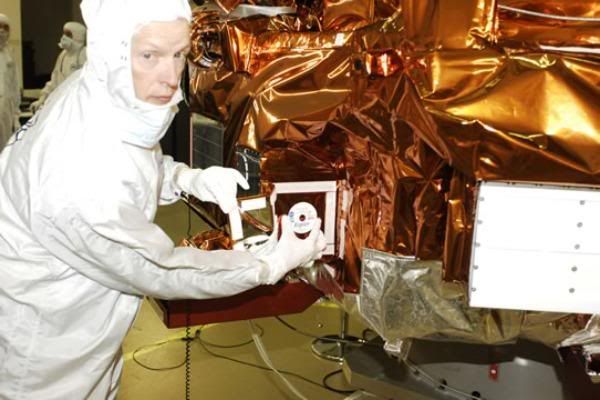
Credit: NASA
In keeping with its earlier messaging practices, NASA included a DVD with the Kepler spacecraft two years ago.
The Kepler was specifically designed to search our region of the Milky Way galaxy for other habitable Earth-size and smaller planets. If by chance it did find life, it had a message.
Unlike the messages from Pioneers 1 and 2 and the Voyager golden record, these messages came from the public. For six-month period, tens of thousands of people submitted messages explaining why the Kepler mission was important. These were then recorded on the DVD, which was attached to the spacecraft.
The spacecraft is still going, so there is still a chance that the message may be discovered.
@ 05 May 2011
Since we have developed the technology, we’ve been sending messages into space ― from scientists, rock stars, students, politicians ― in the hopes that someone or something will hear them and respond. That practice of broadcasting is known as Messaging Extraterrestrial Intelligence (METI). Here are some of the messages that we have beamed into the cosmos in an attempt to get E.T.'s attention.
The Arecibo message

Credit: Cornell University
Beamed out 37 years ago, the Arecibo message is still the most powerful broadcast ever deliberately beamed into space. It was sent from Cornell University’s Arecibo radio telescope in Puerto Rico.
The transmission was aimed at the globular star cluster M13. The cluster is roughly 21,000 light-years from us, near the edge of the Milky Way galaxy, and contains approximately a third of a million stars.
Researchers worked together to create a message that contained basic information about Earth and the life it contained. It including a graphic of the Arecibo telescope, our solar system, human DNA, a stick figure of a human, and some of the biochemicals of earthly life.
The message took only three minutes to transmit, and so far, we haven’t heard back.
Pioneer 10 and 11

Credit: NASA
Pioneer 10 was the first spacecraft to reach Jupiter, Saturn, and beyond the solar system toward other stars. Soon afterward, Pioneer 11 followed its exact flight pattern, and presumably they’re still going, though we have lost contact.
Knowing that these two crafts would make it so far into space and would be traveling for years to come, NASA attached plaques to both Pioneer 10 and 11 with information about Earth.
The 6- by 9-inch gold anodized plaques were bolted to the spacecrafts’ frames; they depict a man – whose right hand is raised as a sign of good will – and woman. In addition, they show the layout of our solar system, as well as our sun’s position relative to a number of pulsars are shown, so that our location can be triangulated from fixed points in space. The hope is that the beings who find it can figure out whence the probe came.
Pioneer 10 was the first spacecraft to reach Jupiter, Saturn, and beyond the solar system toward other stars. Soon afterward, Pioneer 11 followed its exact flight pattern, and presumably they’re still going, though we have lost contact.
Knowing that these two crafts would make it so far into space and would be traveling for years to come, NASA attached plaques to both Pioneer 10 and 11 with information about Earth.
The 6- by 9-inch gold anodized plaques were bolted to the spacecrafts’ frames; they depict a man – whose right hand is raised as a sign of good will – and woman. In addition, they show the layout of our solar system, as well as our sun’s position relative to a number of pulsars are shown, so that our location can be triangulated from fixed points in space. The hope is that the beings who find it can figure out whence the probe came.
Voyagers’ golden record

Credit: NASA
Four years after Pioneer 11 was launched, Voyager 1 and Voyager 2 were sent out to explore Jupiter and Saturn, and NASA decided to take their message to the next level.
Voyager 1 and 2 contain a “time capsule” that, according to NASA, was “intended to communicate a story of our world to extraterrestrials.” The Voyager message is carried on a 12-inch gold-plated copper phonograph disk containing sounds and images selected to portray the diversity of life and culture on Earth.
After the section that contains the sounds of Earth, the record’s creators included a 90-minute section of music that includes both Eastern and Western classics as well as a selection of ethnic music from all over the planet.
The Voyager spacecrafts left our solar system in 1990, and it will be 40,000 years before they make it close to any other planetary system, so we still have a while to wait before we get a return message.
“A Message from Earth”

Credit: Bebo
While Facebook seems to be the social network that has achieved everything, the honor of being the first one to try to network with extraterrestrial intelligence goes to Bebo, which sent out “A Message from Earth” in 2008.
Some 501 photos, drawings and text messages from the site’s 12 million users were transmitted by the National Space Agency of Ukraine's RT-70 radar telescope, which is normally used to track asteroids. The messages were sent to the planet Gliese 581C, which is 20 light-years from Earth, in the hope they would reach intelligent alien life.
Bebo users submitted their messages as part of a competition, and 501 were translated into a binary format, so they could be sent the 120 trillion miles to the Gliese 581C. According to the competition, the messages could cover any range of topics. They should be reaching their destination in 2028.
Cosmic Calls 1 and 2

Credit: S. Korotky
Cosmic Call 1 and Cosmic Call 2, pictograms broadcast from Moscow toward various star systems, featured the “Interstellar Rosetta Stone.”
The “rosetta stone,”developed by Yvan Dutil and Stephane Dumans, was based on mathematical and scientific concepts believed to be universal. The hope was that any alien life form that intercepted the calls would be able to use it to decipher the messages.
The calls were sent out by Alexander Zaitsev, of the Russian Academy of Science in Moscow to sunlike stars within 70 light-years. The first Cosmic Call was beamed toward four separate star systems, 16 Cyg A, Gliese 777, HD 178428 and 15 Sge. The second, reached out to five stars, including 55 Cancri, which is home to a complex planetary system.
The second message also included 50 personal messages from individuals including David Bowie and elementary students from the Ukraine.
The Teen-Age Message

Credit: Farnea via Flickr
In addition to the Cosmic Calls, Zaitsev had his hand in the Teen-Age Message, which was a transmission put together by students from all across Russia.
The TAM transmission was sent out in six sessions in August and September 2001 from the Evpatoria Deep Space Center. It was transmitted to six nearby sunlike stars, some of them with at least one planet.
Like the Arecibo message, TAM had digital information, but Zaitsev and the students decide to include that information in analog format as well, to “compensate for the uncertainty of which is more easily understood by extraterrestrials.”
TAM included personal greetings, messages about Earth, and music that was made with a theremin – the electronic instrument used to make the eerie sounds from 1950s science fiction B-movies.
Doritos commercial

Credit: Doritos
In a 2008 publicity campaign, radars in the Arctic Circle broadcast six hours of a repeating Doritos commercial. Surprisingly, it has not made us targets of an alien attack.
The ad was directed toward a solar system in the Ursa Major constellation, which is only 42 light-years away from Earth. This system has a “habitable zone,” which scientists believe could be host to an Earth-like planet and extraterrestrial life.
The EISCAT European space station on the Norwegian island of Svalbard sent the message using its array of radars. It was sent as an MPEG file coded into 1s and 0s. Researchers agreed that the message would look just like a random series, but they hoped that through its repetition, extraterrestrials would identify the message as intelligent.
RuBisCo message

Credit: U.S. Department of Energy
On the thirty-fifth anniversary of the original Arecibo message, MIT biology fellow and artist Joe Davis sent the genetic code for the plant enzyme RuBisCo into space.
RuBisCo, which is essential for photosynthesis, is the most abundant protein on Earth, which is why Davis selected it to represent life on Earth.
According to Peter Weigele of New England Biolabs, “The choice of this molecule for broadcast communicates the central importance of our sun in sustaining life as well as an implicit understanding of the role of [carbon dioxide] in our biogeochemical systems. This is a message that is both timely and timeless – for the universe and here on Earth!”
This was also the first transmission that required the aid of an iPhone. When Davis arrived at Arecibo, the encoder normally used to modulate the beam was out of commission, so he used his iPhone as an improvised source to get the new coded message modulated into the 1,000-foot-wide dish’s 2-million-watt radio beam.
“Hello from Australia”

Credit: HelloFromEearth/Cosmos Magazine
In 2009, Australia’s Cosmos magazine took a cue from Bebo and reached out to its readers to create a goodwill message to transmit through space.
The magazine’s website collected text-message-length sentiments from people all over the world. The first came from Kim Carr, Australia’s minister for innovation, industry, science and research. It said: “Hello from Australia on the planet we call Earth. These messages express our people’s dreams for the future. We want to share those dreams with you.”
It was sent from the Canberra Deep Space Communication Complex to the planet Gliese 581d ― a planet in the same system as Gliese 581c, which was the recipient of “A Message from Earth.” Australia’s message should be arriving just a year later, in 2010.(original text puts 2029?)
Kepler DVD

Credit: NASA
In keeping with its earlier messaging practices, NASA included a DVD with the Kepler spacecraft two years ago.
The Kepler was specifically designed to search our region of the Milky Way galaxy for other habitable Earth-size and smaller planets. If by chance it did find life, it had a message.
Unlike the messages from Pioneers 1 and 2 and the Voyager golden record, these messages came from the public. For six-month period, tens of thousands of people submitted messages explaining why the Kepler mission was important. These were then recorded on the DVD, which was attached to the spacecraft.
The spacecraft is still going, so there is still a chance that the message may be discovered.
Monday, May 23, 2011
We never went to the MOON (美国人从未登录月球 )
美国人一直宣称他们登上过月球,可是登月火箭为什么连个图纸也没有留下?3个宇航员为什么在登月之前突然死亡?火箭降落月球产生的巨大的反推力把登月舱下面的土都吹得干干净净,可为什么下登月舱时留下人类一大步的脚印?那个脚印真的存在吗?
Part 1
Part 2
Part 1
Part 2
Saturday, May 21, 2011
New life-supporting planet discovered?
Topic : Is the Rocky Alien Planet Gliese 581d Really Habitable?
By Mike Wall, SPACE.com Senior Writer,
Space.com | SPACE.com – Wed, May 18, 2011
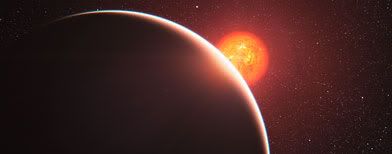
A rocky alien planet called Gliese 581d may be the first known world beyond Earth capable of supporting life as we know it, a new study suggests.
Astronomers performing a new atmospheric-modeling study have found that the planet likely lies in the "habitable zone" of its host star — that just-right range of distances that allow liquid water to exist. The alien world could be Earth-like in key ways, harboring oceans, clouds and rainfall, according to the research.
This conclusion is consistent with several other recent modeling studies. But it does not definitively establish that life-sustaining water flows across the planet's surface.
The new study assumes that Gliese 581d, which is about seven times as massive as Earth, has a thick, carbon-dioxide-based atmosphere. That's very possible on a planet so large, researchers said, but it's not a given. [Video: Life-Sustaining "Super Earth" Gliese 581d]
The Gliese 581 system: Worlds of possibilities
Gliese 581d's parent star, known as Gliese 581, is a red dwarf located 20 light-years from Earth, just a stone's throw in the cosmic scheme of things. So far, astronomers have detected six planets orbiting the star, and Gliese 581d is not the only one intriguing to scientists thinking about the possibility of life beyond Earth.
Another planet in the system, called Gliese 581g, is about three times as massive as Earth, and it's also most likely a rocky world. This planet received a lot of attention when its discovery was announced in September 2010, because it's located right in the middle of the habitable zone. That makes 581g a prime candidate for liquid water and life as we know it — if the planet exists.
Some researchers question the analysis used to discover the planet, and say they cannot confirm 581g in follow-up studies. The planet's discoverers, however, are standing by their find. [The Strangest Alien Planets]
Gliese 581d orbits outside of 581g, far enough away from its star that researchers first thought it too cold for life when it was originally discovered in 2007. But a strong greenhouse effect may warm 581d up substantially, perhaps enough to support liquid water.
That's the tentative conclusion of the new study, as well as several other recent studies by different research teams that also modeled Gliese 581d's possible atmosphere.
Modeling an alien atmosphere
The planet Gliese 581d receives less than a third of the solar energy that Earth does from our sun, and it may be tidally locked (a situation in which one side of the world always faces its sun — a permanent day — and the other faces away, producing eternal night).
After Gliese 581d's discovery, it was generally believed that any atmosphere thick enough to keep the planet warm would become cold enough on the night side to freeze out entirely, ruining any prospects for a habitable climate, researchers said.
The research team tested that possibility in the new study, developing a new kind of computer model that simulates alien planets' atmospheres and surfaces in three dimensions. The model is similar to those used to study climate change on Earth.
When the team ran the model, they found that Gliese 581d probably can indeed host liquid water if it has a dense carbon dioxide atmosphere. Even though the planet is relatively far away from its dim red dwarf parent star, it could be warmed by a greenhouse effect, with daytime heat circulated around the planet by the atmosphere.
The team, led by scientists from the Laboratoire de Métrologie Dynamique (CNRS/UPMC/ENS/Ecole Polytechnique) at the Institut Pierre Simon Laplace in Paris, France, published their results in The Astrophysical Journal Letters.
The work remains speculative.
To determine conclusively if Gliese 581d is truly habitable, future work will probably have to detect and characterize its atmosphere directly. And that is likely years off, since it requires the development of new and advanced telescopes. Human-made probes won't be getting to the planet anytime soon; with current technology, it would take spacecraft hundreds of thousands of years to make the 20-light-year trek
By Mike Wall, SPACE.com Senior Writer,
Space.com | SPACE.com – Wed, May 18, 2011

A rocky alien planet called Gliese 581d may be the first known world beyond Earth capable of supporting life as we know it, a new study suggests.
Astronomers performing a new atmospheric-modeling study have found that the planet likely lies in the "habitable zone" of its host star — that just-right range of distances that allow liquid water to exist. The alien world could be Earth-like in key ways, harboring oceans, clouds and rainfall, according to the research.
This conclusion is consistent with several other recent modeling studies. But it does not definitively establish that life-sustaining water flows across the planet's surface.
The new study assumes that Gliese 581d, which is about seven times as massive as Earth, has a thick, carbon-dioxide-based atmosphere. That's very possible on a planet so large, researchers said, but it's not a given. [Video: Life-Sustaining "Super Earth" Gliese 581d]
The Gliese 581 system: Worlds of possibilities
Gliese 581d's parent star, known as Gliese 581, is a red dwarf located 20 light-years from Earth, just a stone's throw in the cosmic scheme of things. So far, astronomers have detected six planets orbiting the star, and Gliese 581d is not the only one intriguing to scientists thinking about the possibility of life beyond Earth.
Another planet in the system, called Gliese 581g, is about three times as massive as Earth, and it's also most likely a rocky world. This planet received a lot of attention when its discovery was announced in September 2010, because it's located right in the middle of the habitable zone. That makes 581g a prime candidate for liquid water and life as we know it — if the planet exists.
Some researchers question the analysis used to discover the planet, and say they cannot confirm 581g in follow-up studies. The planet's discoverers, however, are standing by their find. [The Strangest Alien Planets]
Gliese 581d orbits outside of 581g, far enough away from its star that researchers first thought it too cold for life when it was originally discovered in 2007. But a strong greenhouse effect may warm 581d up substantially, perhaps enough to support liquid water.
That's the tentative conclusion of the new study, as well as several other recent studies by different research teams that also modeled Gliese 581d's possible atmosphere.
Modeling an alien atmosphere
The planet Gliese 581d receives less than a third of the solar energy that Earth does from our sun, and it may be tidally locked (a situation in which one side of the world always faces its sun — a permanent day — and the other faces away, producing eternal night).
After Gliese 581d's discovery, it was generally believed that any atmosphere thick enough to keep the planet warm would become cold enough on the night side to freeze out entirely, ruining any prospects for a habitable climate, researchers said.
The research team tested that possibility in the new study, developing a new kind of computer model that simulates alien planets' atmospheres and surfaces in three dimensions. The model is similar to those used to study climate change on Earth.
When the team ran the model, they found that Gliese 581d probably can indeed host liquid water if it has a dense carbon dioxide atmosphere. Even though the planet is relatively far away from its dim red dwarf parent star, it could be warmed by a greenhouse effect, with daytime heat circulated around the planet by the atmosphere.
The team, led by scientists from the Laboratoire de Métrologie Dynamique (CNRS/UPMC/ENS/Ecole Polytechnique) at the Institut Pierre Simon Laplace in Paris, France, published their results in The Astrophysical Journal Letters.
The work remains speculative.
To determine conclusively if Gliese 581d is truly habitable, future work will probably have to detect and characterize its atmosphere directly. And that is likely years off, since it requires the development of new and advanced telescopes. Human-made probes won't be getting to the planet anytime soon; with current technology, it would take spacecraft hundreds of thousands of years to make the 20-light-year trek
Saturday, October 2, 2010
Scientists Report Most Earth-like Planet Ever (29/9/2010)
A team of planet hunters led by astronomers at the University of California (UC), Santa Cruz and the Carnegie Institution of Washington has announced the discovery of a planet orbiting a nearby star, Gliese 581, at a distance that places it squarely in the middle of the star's "habitable zone." This would be the most Earth-like exoplanet and the first truly habitable one yet discovered. The research was supported by grants from NASA and the National Science Foundation. "Goldilocks" refers to an exoplanet whose temperatures are "not too cold, not too hot, but just right" to maintain water and support Earth-like life.
Note : The most distant space probe, Voyager 1, was about 14 light-hours away from Earth as of 9 March 2007 (2007 -03-09)[update]. It took that space probe 30 years to cover that distance,[18] and will take over 18,000 years to reach one light-year at the same speed.
Note : The most distant space probe, Voyager 1, was about 14 light-hours away from Earth as of 9 March 2007 (2007 -03-09)[update]. It took that space probe 30 years to cover that distance,[18] and will take over 18,000 years to reach one light-year at the same speed.
Wednesday, October 14, 2009
Life outside EARTH ??
See to believe !!
Life on Mars: NASA. Evidence of Past Life on the Red Planet.(The Origin of Life on Mars)
This video details the scientific evidence proving that microbial life lived on Mars from 4 billion to at least 1 million years ago. A documentary film by Rhawn Joseph, Ph.D.
Life On MARS? - New Scientific Evidence
Scientists announce the discovery of startling artificial Megalithic structures found among recently released NASA / JPL photos taken by the Mars Global Surveyor and that these artificial structures are stunning proof that Mars was once inhabited by an intelligent civilization. Includes a spectacular collection of new photographs presented by Dr. Tom Van Flandern, former Chief Astronomer for the United States Naval Observatory. See remarkable monuments, "T" shaped craters, gigantic glass tube systems, ancient forest remains and grand edifices that will leave you speechless.
Life on Mars: NASA. Evidence of Past Life on the Red Planet.(The Origin of Life on Mars)
This video details the scientific evidence proving that microbial life lived on Mars from 4 billion to at least 1 million years ago. A documentary film by Rhawn Joseph, Ph.D.
Life On MARS? - New Scientific Evidence
Scientists announce the discovery of startling artificial Megalithic structures found among recently released NASA / JPL photos taken by the Mars Global Surveyor and that these artificial structures are stunning proof that Mars was once inhabited by an intelligent civilization. Includes a spectacular collection of new photographs presented by Dr. Tom Van Flandern, former Chief Astronomer for the United States Naval Observatory. See remarkable monuments, "T" shaped craters, gigantic glass tube systems, ancient forest remains and grand edifices that will leave you speechless.
Hubble Deep Field: The Most Imp. Image Ever Taken
In 2003, the Hubble Space Telescope took the image of a millenium, an image that shows our place in the universe. Anyone who understands what this image represents, is forever changed by it.
This is the latest incarnation of the HDF video. The narration has been edited to include research from a paper in Physical Review Letters (2004) which puts the size of the universe at 46.5 billion light years (In the video narration, it was round that value up to 47 billion light years.)
The Hubble Ultra Deep Field in 3D
This is an animation that was rendered using the measured redshift of all 10,000 galaxies in the Hubble Ultra Deep Field image.
It will leads you through a quick history of both deep field images and this video ends with a fly-through of the Ultra Deep Field.
Every galaxy in the image is in its proper distance as viewed from the telescope line of sight.Amazing !!
This is the latest incarnation of the HDF video. The narration has been edited to include research from a paper in Physical Review Letters (2004) which puts the size of the universe at 46.5 billion light years (In the video narration, it was round that value up to 47 billion light years.)
The Hubble Ultra Deep Field in 3D
This is an animation that was rendered using the measured redshift of all 10,000 galaxies in the Hubble Ultra Deep Field image.
It will leads you through a quick history of both deep field images and this video ends with a fly-through of the Ultra Deep Field.
Every galaxy in the image is in its proper distance as viewed from the telescope line of sight.Amazing !!
NEW "DEATH STAR" BLACK HOLE DISCOVERED
A "death star" galaxy that is possibly destroying nearby life forms by firing off powerful jets of particles, has been discovered.
Tuesday, July 21, 2009
Singapore to experience minimal effects of upcoming solar eclipse
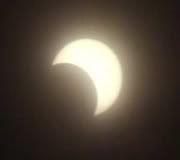
SINGAPORE: Come Wednesday (22th July 2009), China, India and Japan will be seeing its longest total solar eclipse in almost 500 years.
But Singapore will have to wait a little longer to experience the full eclipse.
Scientists said Singapore will only experience a partial solar eclipse between 8.40am and 9.40am.
They added that unlike other countries there will be minimal changes to temperature and visibility.
The Singapore Science Centre will be providing special equipment for members of the public to view the eclipse.
It will also have talks about the astronomical phenomenon. — CNA/vm
A Total Eclipse of the Sun
This video describes how a solar eclipse and lunar occur. The video is a good source for review; especially for the New York State Earth Science Regents. Courtesy of United Streaming.
Saturday, December 27, 2008
The Universe: A Matter of Perspective
An illustration which shows how small our planet Earth is in the larger scope of things. If a human could walk on the surface of Canis Majoris, the largest known star in the universe – he/she would have to walk for 650,000 years to circle the star, compared with 2 years 11 months to complete the same task on the Earth. Knowing that VY Canis Majoris is the largest known star ever recorded... its only 5,000 light years from Earth.
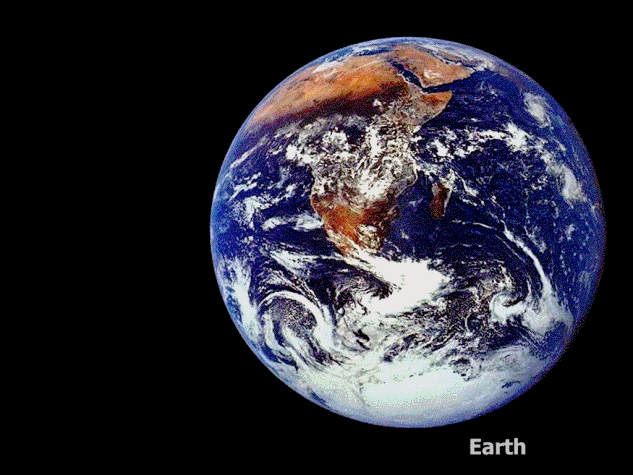
Video
http://video.google.com/videoplay?docid=-3974466981713172831&sourceid=Himself
http://sizeofworldse.ytmnd.com/

Video
http://video.google.com/videoplay?docid=-3974466981713172831&sourceid=Himself
http://sizeofworldse.ytmnd.com/
Subscribe to:
Posts (Atom)


















